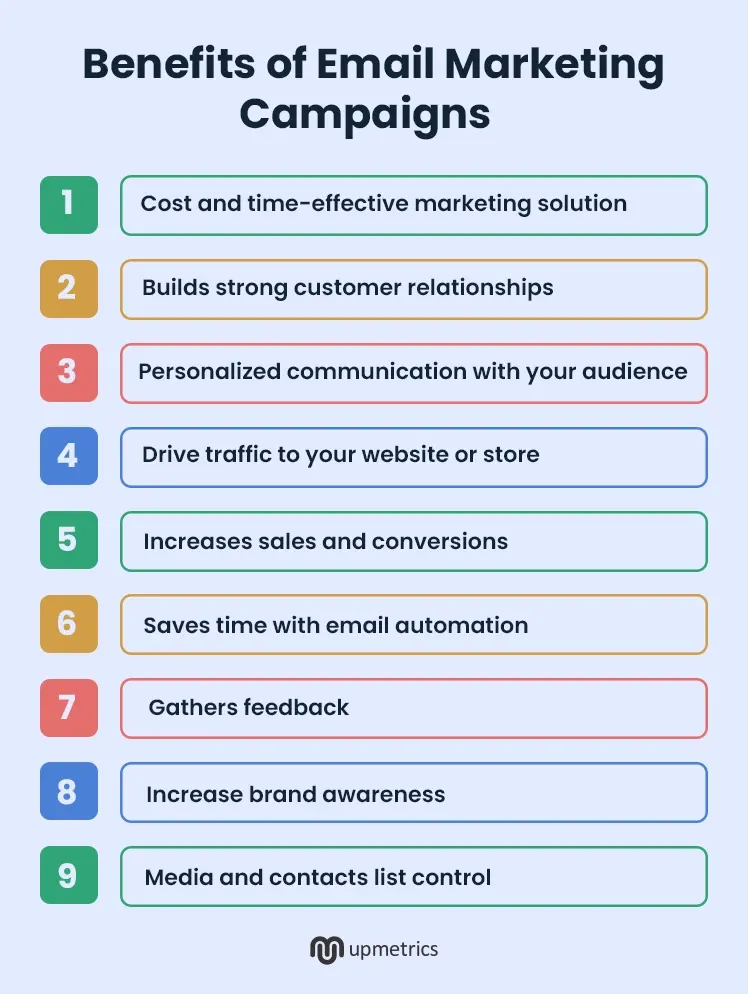We bet you’ve heard about email marketing being dead. Is it really, though?
41% of marketers say it’s one of the most effective marketing channels.
Why? Because email delivers results. It helps you in creating personalized content tailored to your audience. It supports every stage of the customer journey. Plus, it’s the best way to build trust and make strong relationships.
So, what’s stopping you from trying it?
If you’re still not convinced, this article will mention the top 10 benefits email marketing offers. So that you can make a decision on whether to include it in your strategy or not.
So let’s begin.
What is email marketing?
Email marketing is a digital marketing strategy that uses email to engage with customers. With it, you can share updates, and promote products or services. This helps marketers to build relationships, attract leads, and boost sales.
But, what’s so good about it?
Email has been around for decades. And it still remains one of the most effective marketing tools out there.
Even amongst the newer methods like social media and live chat, email ranks first for the most impactful marketing channels.
And with over 4.37 billion users and a market expected to reach $32.82 billion by 2035, email isn’t going anywhere.
So now that you know about its importance, let’s explore its benefits and learn why it still should have a top spot in your marketing plan.
Benefits of email marketing campaigns
For small businesses with a limited marketing budget, email marketing can deliver impressive results. Here are ten benefits that email marketing can bring to your business:

1. Cost and time-effective marketing solution
Traditional marketing methods like print ads or direct mail can be costly. Just think about it. Costs for photoshoots, location fees, printing, mailing, and placement can add up quickly.
But with email marketing? It’s different.
Here’s why:
Minimal production costs
You don’t need expensive photoshoots or printing. All you need is a copywriter, email marketing software, and maybe a graphic designer (or just stock images). This can even be handled by one person on your team!
Quick turnaround
Need to get the word out fast? Create and send a successful email outreach campaign in just one day. Compare that to the weeks it might take for a print or direct mail campaign.
The best part? You’re saving time and money while still reaching your audience.
2. Builds strong customer relationships
Email marketing allows you to connect and provide value to your customers. It can build trust and loyalty if you share helpful and relevant content.
When your emails prioritize value over sales pitches, subscribers notice the effort. They begin to look forward to your messages, strengthening their connection to your brand.
You can build these relationships by:
- Sharing useful tips, like quick how-tos or industry insights.
- Offering exclusive content, like free guides or insider news.
- Building trust by spotlighting real customer stories or testimonials.
And don’t forget to bring social media into the mix. Adding links to your accounts in every email encourages subscribers to follow you, creating more touchpoints for engagement.
Social media complements your email efforts by offering additional content, updates, and a sense of community. When subscribers trust your emails, they’re more likely to explore your social platforms, deepening their relationship with your brand throughout the customer journey.
3. Personalized communication with your audience
71% of consumers want highly personalized interactions with brands. Plus, 76% feel frustrated when they don’t get them.
The beauty here is that emails can be personalized.
Through email marketing, you can make your content stand out by sending personalized messages. It creates value and helps your audience feel a real connection to your brand.
To top it off, it:
Makes your brand relatable
Adding a human touch to your emails helps you foster loyalty and drive better results.
For instance, personalized subject lines can increase open rates by 26%. People feel valued when your message feels like it’s made just for them. This can make them more likely to take action.
Whether it’s clicking a link, signing up for an offer, or making a purchase. The aim should always be to make your emails more personal to your audience.
Boosts engagement
Email marketing allows you to segment your audience into smaller groups based on traits like age, location, or purchase behavior.
This segmentation helps you send content that’s not only relevant but also solves their specific problems. Relevant emails drive better engagement, leading to more conversions.
4. Drive traffic to your website or store
Having a website is important, but driving traffic to it is a difficult task. Email marketing makes this easier by allowing you to include direct links to your site in every message. You can do this by sending weekly newsletters that keep your audience updated.
Email marketing can build your brand’s value and trust, by sharing useful information.
For example, Atlas Obscura’s newsletter doesn’t just give travel tips—it shares interesting stories about the world. By including a ‘read more’ link, they encourage readers to visit their site and explore further.

Plus, emails are also a great way to promote special deals or free trials. This helps in drawing more visitors to your website.
Adobe Express does this by letting people try their premium editing software for free.

This not only boosts sales but also brings more visitors to their website.
5. Increases sales and conversions
Email marketing isn’t just about connecting with your audience. It’s a solid way to drive sales too.
In fact, for every dollar spent on email marketing, you get an average ROI of $36. Whether it’s featuring your products, making people complete their abandoned carts, or sharing exclusive offers, email gets the job done.
For example, look at Adidas:

They send out simple emails highlighting sales, and it works.
The best part? These are people who’ve already signed up to hear from you, so they’re inclined to take action.
6. Saves time with email automation
Email automation is a huge part of email marketing. It helps you send personalized messages based on what your customers do automatically.
Whether it’s a welcome email, a product suggestion after purchase, or a reminder about items left in a cart, it gets the job done. This happens on setting rules to trigger emails automatically.
Plus, it keeps your audience engaged, introduces your brand, and brings them back—all without extra effort.
For business owners, time is valuable. Instead of manually sending emails, automation handles the work for you giving you more time to focus on growing your business while still delivering quality communication.
It’s also a great way to nurture leads. Sending the right email at the right time can turn potential customers into loyal ones. Whether it’s a special offer or a cart reminder, automation makes sure your message gets to the right people without extra effort.
7. Gathers feedback
No business gets everything right all the time. And the best way to find out what needs work is simple—ask your customers.
Email marketing makes this easy. With just a few clicks, you can:
- Send out quick customer satisfaction surveys.
- Ask for feedback directly through a friendly email.
This way you can find what your customers like and what they think could be better.
When you act on their feedback, it shows you care about their experience. That builds trust and keeps them coming back.
8. Increase brand awareness
To grow your brand, you need to stay connected with your audience. Regular communication keeps your business fresh in their minds. Plus, it helps them stay up to date with what you’re doing.
Email marketing makes this easy. Sending updates keeps both your existing customers and new customers engaged. Automated emails are even better—they let you stay in touch without taking up a lot of your time.
You can also use your emails to grow your reach. Adding social media links lets subscribers share your content with others, introducing your brand to a wider audience.
Plus, email tools give you valuable feedback. Email analytics offer useful insights too. You can track open rates, clicks, and other metrics to see what works and improve your email marketing strategy.
9. Media and contacts list control
Relying on social media channels alone to connect with your audience isn’t advisable. Why? Because you don’t own your followers or even the content you share there. It all belongs to the platform.
Now imagine if your favorite platform shuts down tomorrow. How many followers—and potential customers—would you lose overnight? Yikes.
This is why building an email list is important for marketers. Your email list is yours. You own it, and you control how and when you communicate with your audience. Unlike social media platforms, your emails reach people directly, no matter which platform they prefer. Plus, the content you create and send is also fully yours.
And if you’re trying to reconnect with past contacts or reach new ones, you can even find emails through tools that offer free email lookup. Just be mindful of privacy and ethical use.
Email marketing is personal, direct, and still the go-to place for people who want updates from brands. On top of that, it drives real results. It helps you to increase sales, generate leads, and stay connected.
Tips to measure and improve email marketing campaign performance
Metrics like opens, clicks, and undelivered emails play a big role in your email marketing campaign’s success. They help you spot the small details that can make one campaign outperform another.
To get the most out of your performance tracking, here’s what you should do:
1. Set a tracking schedule
Whether it’s weekly, monthly, or quarterly, after each email marketing campaign, regular tracking helps you compare results against benchmarks and past performance.
This can reveal trends or patterns, like which email types or audience segments perform best, or how external factors might be influencing results.
2. Establish clear goals
What do you want each campaign to achieve? Setting measurable objectives early on helps ensure your tracking stays focused and relevant.
3. Dig into the data
Look at what’s engaging your audience—like which links or images drive the most clicks. At the same time, identify what isn’t working. This kind of analysis helps you learn more about your subscribers’ interests.
Plus, it helps you to know how to better connect with them in future email campaigns.
Summing it up
If you’re thinking about email marketing or wondering if it’s working for you, I hope this article shows you its value for your business.
But remember, you need a solid email marketing plan. Only then will email marketing work. But remember it takes time and patience.
So, be there, and don’t give up!
